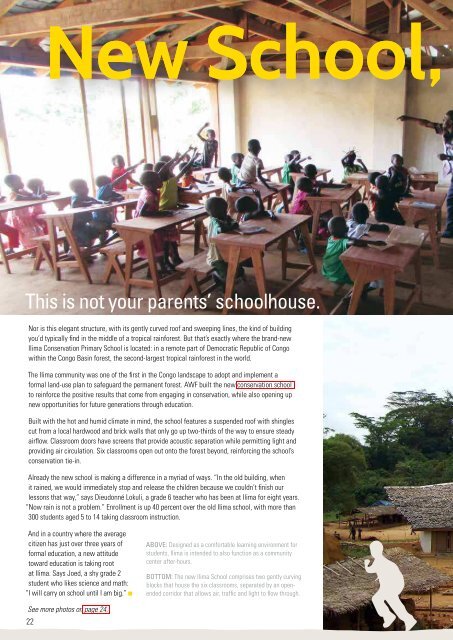awf-2014-report
awf-2014-report
awf-2014-report
You also want an ePaper? Increase the reach of your titles
YUMPU automatically turns print PDFs into web optimized ePapers that Google loves.
New School, New Skills...<br />
The school is sited in a location that bridges both untouched forest and<br />
agricultural areas, reinforcing the importance of the land and natural<br />
resources.<br />
Many elements of the school were built by local hands using local materials.<br />
Community members, for example, were trained in how to make and<br />
install roof shingles from a local hardwood—a skill that they can then use<br />
for future maintenance.<br />
Elements of the school are beautifully designed and utilitarian: Classroom<br />
doors have screens that provide acoustic separation while letting in light<br />
and air; similarly, screens around the latrine provide privacy while also<br />
allowing for cross-ventilation.<br />
This is not your parents’ schoolhouse.<br />
The building was designed with the humid tropical climes in mind, with<br />
brick walls that go up two-thirds of the way to the ceiling to allow for<br />
unrestricted airflow.<br />
Nor is this elegant structure, with its gently curved roof and sweeping lines, the kind of building<br />
you’d typically find in the middle of a tropical rainforest. But that’s exactly where the brand-new<br />
Ilima Conservation Primary School is located: in a remote part of Democratic Republic of Congo<br />
within the Congo Basin forest, the second-largest tropical rainforest in the world.<br />
The Ilima community was one of the first in the Congo landscape to adopt and implement a<br />
formal land-use plan to safeguard the permanent forest. AWF built the new conservation school<br />
to reinforce the positive results that come from engaging in conservation, while also opening up<br />
new opportunities for future generations through education.<br />
Built with the hot and humid climate in mind, the school features a suspended roof with shingles<br />
cut from a local hardwood and brick walls that only go up two-thirds of the way to ensure steady<br />
airflow. Classroom doors have screens that provide acoustic separation while permitting light and<br />
providing air circulation. Six classrooms open out onto the forest beyond, reinforcing the school’s<br />
conservation tie-in.<br />
Read about the latest<br />
happenings at Ilima.<br />
Already the new school is making a difference in a myriad of ways. “In the old building, when<br />
it rained, we would immediately stop and release the children because we couldn’t finish our<br />
lessons that way,” says Dieudonné Lokuli, a grade 6 teacher who has been at Ilima for eight years.<br />
“Now rain is not a problem.” Enrollment is up 40 percent over the old Ilima school, with more than<br />
300 students aged 5 to 14 taking classroom instruction.<br />
And in a country where the average<br />
citizen has just over three years of<br />
formal education, a new attitude<br />
toward education is taking root<br />
at Ilima. Says Joed, a shy grade 2<br />
student who likes science and math:<br />
“I will carry on school until I am big.”<br />
ABOVE: Designed as a comfortable learning environment for<br />
students, Ilima is intended to also function as a community<br />
center after-hours.<br />
BOTTOM: The new Ilima School comprises two gently curving<br />
blocks that house the six classrooms, separated by an openended<br />
corridor that allows air, traffic and light to flow through.<br />
See more photos on page 24.<br />
22<br />
23


